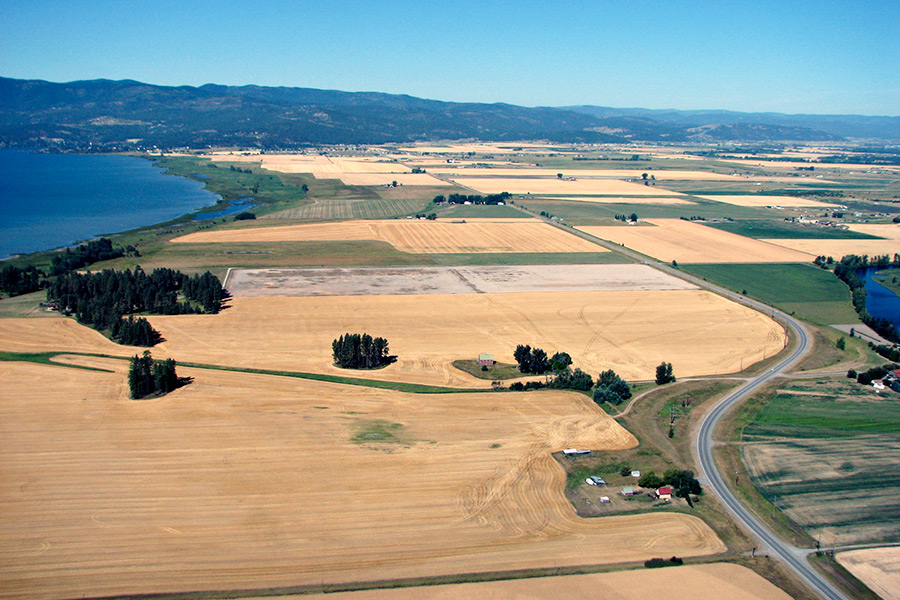Paul Travis has a pair of maps shaded in varying degrees of green and brown, signifying the densities of developed and undeveloped lands in the Flathead Valley.
One map, from 1970, is coated in green with small segments of orange where the valley’s towns exist.
The other map, from 2010, is mostly tanned with residential and commercial growth, spreading from Kalispell, Whitefish and Columbia Falls toward the outlying mountain ranges and lakes.
Indeed, Flathead County’s population has more than doubled in that timeframe, from nearly 40,000 people to over 93,000.
Looking at both maps and the continued growth in population and development, Travis, the executive director of the Flathead Land Trust, asks: What will the Flathead Valley look like in 2050?
This question lies at the center of the Flathead Land Trust’s new conservation plan, which was unveiled late last month. After gathering input from community members and stakeholders, the local nonprofit organization crafted an updated blueprint guiding efforts and attention for the coming years.
This latest plan replaces the previous strategy that was released in 2006 with added emphasis on three key areas: community projects such as trails and other popular community projects; habitat conservation projects including conserving migratory bird habitat; and agricultural conservation projects to conserve the valley’s farmlands.
“Those three areas that we spell out in the new conservation plan are where we’re putting more emphasis and time and doing more outreach and working with landowners within those areas,” Travis said. “We’ve heard from the community that they would like their local land trust to focus on these issues and that’s what we’re trying to do.”
The previous conservation plan focused the organization’s efforts on the Flathead River to Lake Initiative, a collaborative effort to protect the most critical open space lands along the Flathead River and north shore of Flathead Lake. The initiative led to successfully protecting over 5,000 acres since 2002, adding to a conservation network totaling over 11,000 acres of private and public lands.
This latest plan circles around the overall goal of conserving open space in a rapidly growing valley. The plan notes that Flathead County is one of the fastest growing counties in the state, increasing its population at an estimated 1.5 percent a year. An estimated 23,000 more residents are expected to live in the county by 2050, which is the equivalent of adding another city the size of Kalispell to the county over the next 35 years. This doesn’t include the growth in seasonal visitors experienced each year.
“As population growth results in more residential housing, commercial development and infrastructure and contributes to the region’s economic prosperity, it also comes with some loss of the open space lands, fish and wildlife habitat, and clean water we all cherish. Our conservation plan is intended to prioritize which private lands to try and conserve before it is lost to development,” said Ryan Hunter, the Flathead Land Trust employee responsible for developing the plan.
The plan highlights the valley’s diverse range of bird species, especially around the north shore of Flathead Lake. Montana Audubon designated the north shore as an Important Bird Area in 2009. More than 229 species have been recorded for the general area, of which 172 are regulars, according to FWP.
The land also acts as a natural filter for groundwater entering the lake.
Protecting habitat for these species is critically important, Travis said.
Farmlands throughout the Flathead are also in danger of disappearing, Travis said, and those lands foster important characteristics such as rich soil and groundwater sources.
“These open spaces are disappearing the fastest and it’s important to keep the farmlands and farming as part of the cultural and economic fabric of this valley,” he said.
The new plan also directs the organization to seek partnerships with other organizations for recreational projects, such as the Whitefish Trail and Foys to Blacktail Trail.
“That’s something we’ve already been doing but this gives us more direction to try to do even more of this in a more concerted way,” Travis said.
Flathead Land Trust was founded 30 years ago by a group of community members who saw the likelihood of the valley’s urban growth in the years ahead and were interested in preserving some of its original rural character. The organization’s primary role is to negotiate voluntary conservation agreements with private landowners ensuring that the open spaces, wetlands, wildlife habitat and other conservation values of the private land are maintained in perpetuity.
Travis is quick to point out that Flathead Land Trust is not “anti-development,” but instead is focused on balancing the residential, commercial and industrial growth with traditionally open space and natural habitat.
“We’re trying to look for ways we can use land conservation to create other opportunities for people and ways that are valuable to the community,” he said.
The Flathead Land Trust is hosting a boat tour of the north shore of Flathead Lake on July 14 to celebrate Open Land month. The charter boat tour will be on the Far West from 6-9 p.m. Tickets may be purchased for $20 each. Reserve a spot at 752-8293 [email protected].
To read the new conservation plan, visit http://www.flatheadlandtrust.org.
